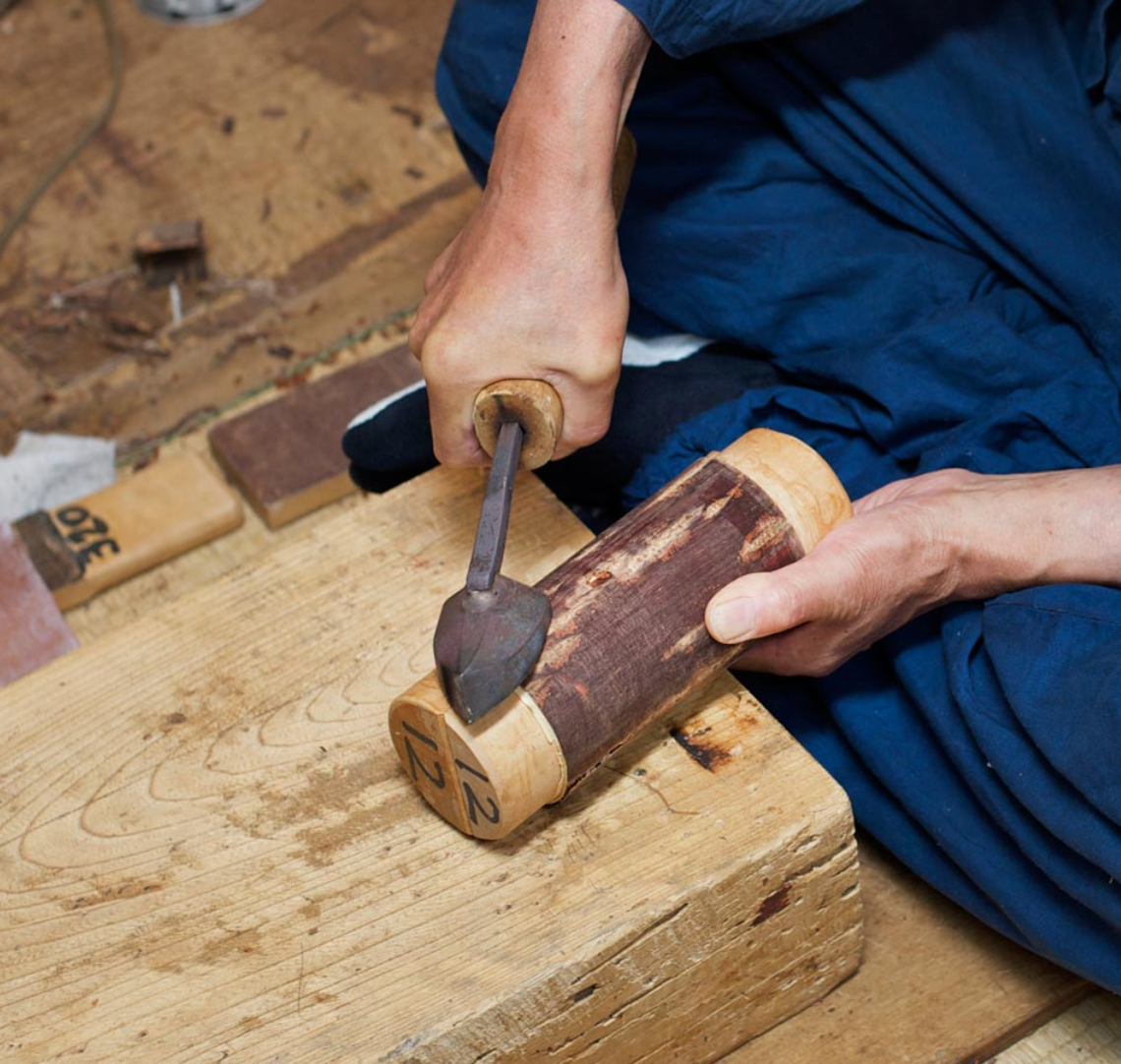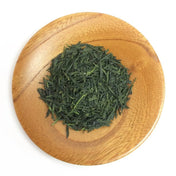Tea caddies have been important for Japanese tea for hundreds of years and have carried particular prestige since the great warlord Oda Nobunaga (1534-1582) ranked tea ceremony utensils for their aesthetic value. Tea caddies, including “The three great tea caddies of the world”, named Hatsuhana, Narashiba and Nitta, have held extremely significant cultural and political value, the gift of a tea caddy once being used to appeal for mercy in battle. Only the great warlord Hideyoshi was powerful enough to possess all three of the great tea caddies at the same time. These were small, extremely delicate, ceramic tea caddies with a narrow mouth and wider shoulders, called katatsuki, and were actually brought from China in the Sengoku Period (1467-1615).
Tea caddies utilized in the traditional Japanese tea ceremony (i.e., for matcha) are generally referred to as chaki (meaning, tea implement). If you have ever witnessed or attended a traditional Japanese tea ceremony, you may have noticed that the matcha powder is kept in an elegant small container. Tea caddies are classified both by their shape and material, as well as by the type of tea preparation (thin tea or thick tea) for which they are used. The type of tea caddy called natsume or usuchaki (i.e., thin tea implement) is the specific type that is primarily used to store and present the matcha used for making usucha, thin tea. Conversely, the ceramic vessels utilized to store matcha powder to make koicha (i.e., higher grade thick matcha) are called cha-ire. In the tea ceremony, there is an art of carefully selecting and presenting the tea caddy. It is purposely chosen to harmonize with the other matcha tools used for the occasion, and is therefore among the items the guests pay particular attention to.
 Natsume Photos by PhotoDesignTokyo.
Natsume Photos by PhotoDesignTokyo.
Ceramic tea caddy craft certainly continued on after the time of the great warlords, with Japanese master potters making exquisite katatsuki throughout subsequent periods and on to the present day. However, during the Edo Period (1603-1868), sencha started to gain popularity, especially among non-nobles. Japanese craftspeople thus branched out from small ceramic tea caddies and started working with tree bark, primarily cherry, and bamboo to make larger tea caddies suitable for sencha.
What you might call a third wave of Japanese tea caddy craft initiated just after the Meiji Restoration (1868 ~ ) thanks to newly available tinplate imported from England. With this new material, very tight fitting smooth cylindrical tea canisters became available to a much larger portion of the population. Around the same time, tea began to be more enjoyed amongst the common people which created a demand for a container to store tea (i.e., in place of the formerly utilized large tea jar called chatsubo). This historical background was what led to the birth of handmade tin tea canisters. In fact, this was when craftsmen like Kiyosuke Yagi (whom I will elaborate on in the subsequent paragraphs) saw an opportunity to be innovative. *Please note that in this post, I will refer to the more modern tea caddies as tea canisters although the term tea caddies is all encompassing referring to a box, canister, jar or other receptacle used to store tea.
Kaikado's 130 steps to elegant airtight tea canisters
Kaikado is a famous tea canister company based in Kyoto city known for their elegantly hand-crafted tea canisters that have been passed down from generation to generation, for over 140 years! Craftsman Kiyosuke Yagi (first generation) became the first to provide the Japanese people with the new model tin tea canisters, called chazutsu in Japanese.
This is perhaps where traditional Japanese craftsmanship deserves to be spotlighted. An impressive fact is that there are 130 meticulous steps needed to make the traditional tea canister at Kaikado, and this is still the process that is followed today. These steps are vital in order to make the airtight closure essential for storing tea leaves, especially in a humid environment such as Japan. For instance, during the process of cutting the materials needed to make the tea canister, it is very important to apply the same amount of force each time during the cutting process because any kind of subtle misalignment will affect the final product. In order to use the same diameter for the lid and the main body of the tea canister, the craftsman will write a number on each part and then cut them. After adjusting any distortions and/or curls, the rounding process begins. For making the tin sheets into a perfect circle, there is a special tool called a “sanbon” roll (literally, 3 rolls). Then, the rolled-up body and lid will be clipped with a unique clipping tool called a “Hassou”. At Kaikado, there are about 10 craftsmen who divide up the work, but only the 5th and current 6th generation craftsmen can complete the entire process by himself.
One often reads that when the lid of the tea canister at Kaikado is aligned with the main body of the container, it slides down ever so perfectly as if it were sinking gently down like the sunset and closes tightly… While I have yet to come into contact with one of these tea canisters from Kaikado, with their expertly crafted tea canister, one is sure to be able to preserve the freshness and aroma of high quality tea leaves. Kaikado’s current 6th generation Takahiro Yagi is now challenging himself with new ways to be innovative with the knowledge that if he fails, there will always be the chazutsu at his core to support and sustain him. One of his new projects started a couple of years ago in 2016, when he opened a cafe called Kaikado Cafe by renovating a no longer used Western style building of Kyoto City Electric Company. At his cafe, Yagi-san does not want to just focus on tea canisters or the future of Kaikado. His intentions are to allow his customers to experience traditional Japanese craftsmanship applicable to people’s day-to-day lives.
Diversified tea canisters today
Nowadays, there are a wide-array of types, sizes, and prices of tea canisters. The standard modern Japanese one, like the one made at Kaikado, is made of tinplate. Tinplate is made by coating the surface of iron with tin, and is characterized by its light weight and resistance to rust. Other materials used for the metal types of tea canisters include brass, aluminum, stainless steel, copper, or other thin metals like silver. It is said that tin tea canisters are considered to be the best in Sencha-do (i.e., the way of sencha).
Other types of tea canisters that one may come across in Japan are made out of ceramic and wood. Ceramic tea canisters, wheel thrown by master potters and baked in kilns, are often shaped like a small flower vase with a spiral pattern on the bottom of the caddy. In contrast to the tin plate tea canister, their appearance is rather imperfect, wabi-sabi style. Wooden tea canisters are also a unique form of traditional craftsmanship as they are made by hollowing out the contents using a woodturners lathe. Some models leave the natural wood grain in a natural state, while others are finished with lacquer. Various types of wood have been utilized for tea canisters such as cherry, oak, zelkova, and others.
Fujiki Denshiro, a company based in Akita Prefecture (Northern Japan) specializes in kabazaiku, or sakura wood bark crafts. This company was actually established a bit earlier than Kaikado (in 1851) as a kabazaiku wholesaler and then transitioned into the very first kabazaiku manufacturing studio with 6th generation owner Koichi Fujiki. Their cherry bark tea canisters (depicted below) which we handle at Yunomi are quite beautiful as well, and also deserve praise for their exquisite craftsmanship. Further, Fujiki-san had an ongoing collaboration with designer Kaichiro Yamada since the year 2009 in efforts to develop a contemporary tea canister that would be applicable to the lifestyle of an apartment in the city. This is when they came up with the Wazutsu-series chazutsu which utilized cherry, maple and walnut wood in addition to cherry bark.

Sachiko-san, on Yunomi has written more extensively on the art of kabazaiku, if you are keen about this type of tea canister or craftsmanship in general, her post may be of interest.
Going beyond tea and the modern use of tea caddies
Today, Japanese tea canisters are used for storing tea leaves but their utility has become more versatile. While this may take people by surprise, tea canisters are well-suited for the storage of dried foods, such as chili peppers, uncooked beans and pasta, herbs, and more. Of course, tupperware can also be used and sealed, but light can easily pass through owing to the nature of the material. In this respect, tea canisters are able to be tightly closed without light exposure and therefore serve as a great storage container, similar to the use of mason jars. One downside to keep in mind may be that one will have to label the contents with masking tape or, simply, remember what is inside! While I simply appreciate the modern day tea canisters for its original tea storing purposes, it is exciting to see the evolution and transformation of the chazutsu and traditional Japanese craftsmanship.
To wrap up, I will share with you my somewhat disappointing but unsurprising discovery (ha) of an informal survey I did with respect to tea canister use amongst the Yunomi staff. Considering the fact that we are a small group of 10 and a non-random sample, this survey is of course not generalizable to the Japanese population. However, in general, it seems that over half of our staff do not own tea canisters at home. Others of us have several. In my house we have one for matcha (with the bag rolled up inside!), one each for hojicha and kancha and another one with beans. Ian Chun, founder of Yunomi has one at home but he prefers storing tea in their original bags, which I find to be typical amongst the Japanese. He did mention that it is nice to have a tea canister to bring out to the dining table when guests are over. Perhaps, having a traditional or high quality tea canister will spark conversation, or simply create a sense of cha no ma (tea space and atmosphere). Interestingly, while tea canisters may not be utilized very frequently in the daily lives of the majority of Japanese, they still continue to be given and received as gifts. Which makes me wonder whether this comes from the historical roots of tea caddies holding prestige, cultural and political value.
 Tea canisters owned by Yunomi staff. Left: Tea canisters from Okumura Seikan with washi paper. One is for storing hojicha, the other is for storing sencha. Right: Some people do not own Japanese tea canisters per se but simply store their Japanese tea or tea bags in rectangular tea caddies that were initially for storing other teas. How do you store your tea?
Tea canisters owned by Yunomi staff. Left: Tea canisters from Okumura Seikan with washi paper. One is for storing hojicha, the other is for storing sencha. Right: Some people do not own Japanese tea canisters per se but simply store their Japanese tea or tea bags in rectangular tea caddies that were initially for storing other teas. How do you store your tea?
Related Links and articles:
- Kaikado: https://www.kaikado.jp/english/
- Kaikado Cafe: https://www.kaikado-cafe.jp/
- Fujiki Denshiro: https://denshiro.jp/en/
- Tea canister collection on Yunomi
Featured image: One of the techniques (called katamono) to make cylinders for tea canisters in kabazaiku. In the image, the craftsman is gluing together layers of cherry bark and wood. He will wrap them around a cylindrical wooden mold and then iron them with a highly heated trowel to attach them. All parts of the tea canister are therefore made from one cylinder and this is what gives the tea canister its' high airtightness. Photo by Fujiki Denshiro.
Have additional insights about tea caddies? Please don't hesitate to post comments and/or questions below. Or directly contact me (Moé Kishida): moe@yunomi.life. Thanks for reading!


